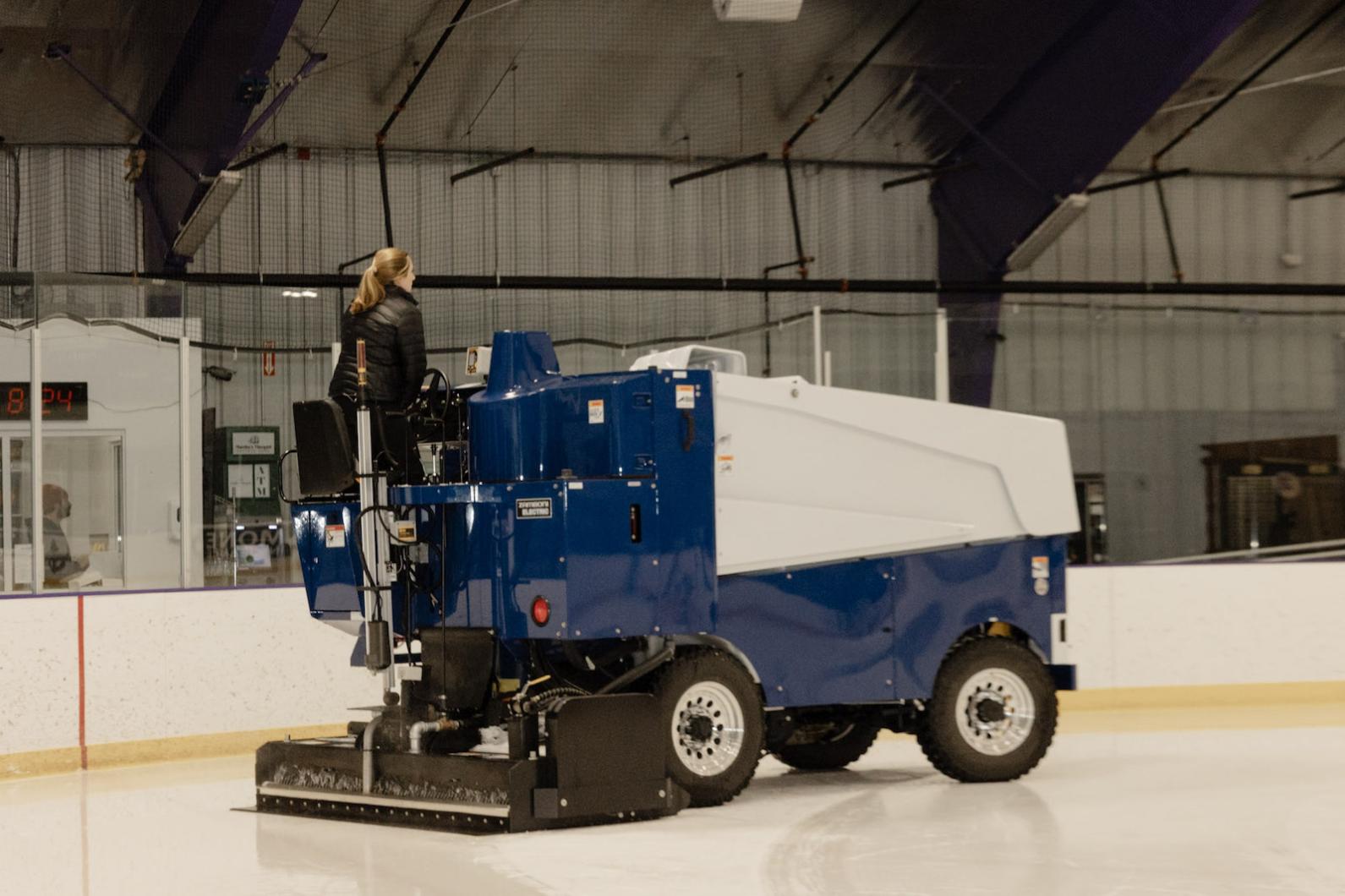Jo Douglas spends much of her summer behind the wheel of her pickup truck, the flatbed loaded with gray barrels of kitchen waste destined to feed her up-Island hogs as part of her Fork to Pork operation.
In the off-season, though, after the year’s pork has been butchered and sold, Ms. Douglas can be seen behind a much different wheel: the Zamboni at the Martha’s Vineyard Ice Arena. She is one of eight drivers smoothing the ice all winter long, and the first woman to hold the job on Island.
“There’s so many summer seasonal jobs, but there’s very few winter seasonal jobs,” Ms. Douglas said of her dual roles, from farm to rink.
As pumps whirred beside the Zamboni in the ice arena maintenance room, circulating ice-cold refrigerant in pipes below the ice, Ms. Douglas expounded on trying to find her way in the Island’s seasonal economy, a task familiar to many on the Vineyard.
“I think of myself as a farmer first,” she said.
Ms. Douglas founded Fork to Pork back in 2019 on three acres leased from the Land Bank near Wapatequa preserve. There she feeds a herd of about a dozen pigs on food scraps she collects from local restaurants, fattening them up for slaughter and sale throughout summer.
“They can put on a pound a day,” she said.
Last year, she added a Leaf to Beef cow pasturing operation to the mix, another summertime operation.
While some livestock farmers overwinter part of their herd, that strategy doesn’t fit Ms. Douglas’ one-woman operation. The cost to import hay for the cows, she said, is too expensive, and not enough restaurants are open in winter to collect scraps to feed her pigs.
More than the cost, though, running a full-time livestock farm year-round would be too much for one person to handle.
“It’s for the sustainability of my life,” she said. “I don’t want to be caring for animals seven days a week, all year, because it’s just me.”
And so, after her annual farming operations are finished, Ms. Douglas moves to her off-season gig as Zamboni driver at the ice arena. The two roles, she said, have a certain degree of overlap.
“At the interview they were like ‘Have you driven any large pieces of machinery that you can be very precise in?’ and I was like, ‘Yeah, I hay with tractors,’” she said.
Ms. Douglas was already well acquainted with ice rink culture, playing competitive hockey in high school, but taking up a role as steward of the rink brought a whole new appreciation for what it takes to do the job.
“I used to not be an ice snob, but now I am,” she said. “You have people that are like, ‘You missed a spot!’ It’s a lot of pressure.”
While the boys varsity team scrimmaged on the ice, slicing and gouging its surface ahead of the next round of resurfacing, Ms. Douglas described the mechanisms of the machine.
As the Zamboni circles the rink, she said, the machine’s blade scrapes the roughest layer of ice away into shavings – those shavings, gathered into a tank by a series of augur screws, are the source of the large “snow” piles often seen outside the rink.
After the shaving, the machine releases a layer of warm water onto the ice, melting down the remaining inconsistencies and refreezing it into a smooth surface.
“It’s about the steering, the technique,” she said of the skills required. “If you go off a little bit you’re missing a big chunk of ice.”
With the amount of skating that goes on at the rink, a good Zamboni driver is key. Between boys and girls varsity and junior varsity high school teams, four age brackets for youth hockey, several adult leagues, figure skating and weekly public skating, the ice can get pretty torn up. Ms. Douglas is one of eight Zamboni drivers who resurface the rink, around seven times a day.
“It’s like the winter happening spot here on the Island,” she said, a community she has become deeply embedded in. In addition to resurfacing the ice, Ms. Douglas is the assistant coach for the high school girls J.V. team, coaches girls youth hockey, competes in the adult co-ed league and keeps score for the men’s league.
“I’m always on the ice, it’s great,” she said.
Ms. Douglas has a few more months left in her off-season role as work prepping the pastures begins in April. But day-to-day, she remains focused on the ice. As the boys varsity team glided off the rink after practice, and the J.V. girls suited up for theirs, the Zamboni roared to life, a great gleaming vehicle, angular and lapis blue,
Ms. Douglas slowly circled the rink, weaving the machine in long, overlapping ovals. She leaned out to one side as she did so — she is too short, she said, to see over the top — and periodically pumped the machine's “plunger,” clearing stuck ice shavings blocking its pipes.
Behind her, once-dull ice turned wet and smooth, shimmering under cold fluorescent light.









Comments (6)
Comments
Comment policy »